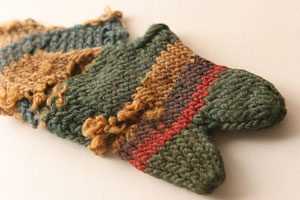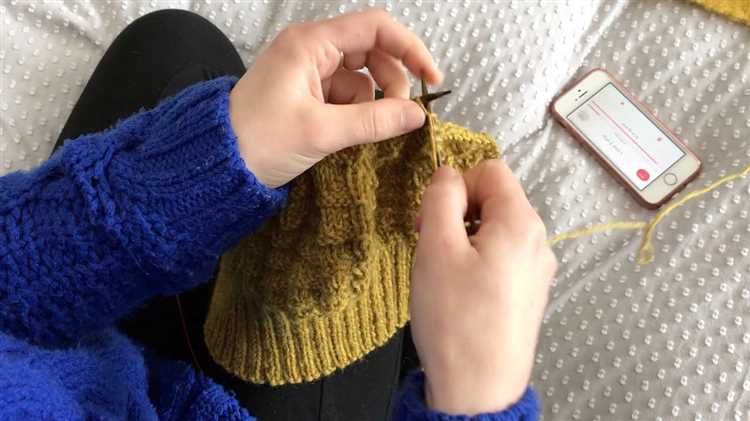Knitting is an ancient craft that has been practiced for thousands of years. It is believed to have originated in the Middle East or North Africa, with some of the earliest examples of knitted items dating back to the 3rd century AD. The craft of knitting involves creating fabric by interlocking loops of yarn with two or more needles. It is a versatile technique that can be used to create a wide range of items, from clothing to accessories and even home decor.
The exact origins of knitting are still uncertain, but it is believed to have developed as a way to create warm and durable garments. Early knitted items were made using techniques known as “nålebinding” or “nalbinding,” which involved using a single needle to create a series of interconnected loops. Over time, knitting evolved to include the use of two or more needles, allowing for more complex patterns and designs.
Knitting has played a significant role in various cultures throughout history. In ancient Egypt, knitting was considered a high-status skill, and knitted garments were often worn by royalty. In Europe during the Middle Ages, knitting became an important industry, and guilds were formed to regulate the craft.
“Knitting has played a significant role in various cultures throughout history”
In the 16th century, knitting became more accessible to the general population as the production of knitting needles and yarn became more widespread. The craft continued to evolve, with new techniques and patterns being developed. Knitting patterns were passed down through generations and shared among communities, creating a rich tradition of knitting that continues to this day.
Today, knitting is a popular hobby enjoyed by people of all ages and backgrounds. It offers a creative outlet and a way to relax and unwind. Knitted items are highly valued for their warmth, comfort, and unique handmade quality. Whether you’re a beginner or an experienced knitter, exploring the history of knitting can deepen your appreciation for this timeless craft.
Ancient Origins of Knitting
While the exact origins of knitting remain a mystery, evidence suggests that knitting has been practiced for thousands of years. The earliest known examples of knitting date back to the 3rd century AD, discovered in the Middle East and Egypt.
Knitting is believed to have developed from techniques used for making nets and other forms of fishing gear. Ancient fishermen likely used rudimentary tools, such as bone or wooden needles, to create intricate patterns and structures with their yarn.
By the 11th century, knitting had spread throughout the Arab world and reached Europe via Spain. The craft quickly gained popularity among the upper classes, who considered knitted garments to be a symbol of wealth and status.
During the 16th century, knitting became an important livelihood for many European women. The creation of the stocking frame knitting machine in the late 16th century revolutionized the industry, making it easier and faster to produce knitted items.
Knitting techniques and patterns have evolved over time, influenced by various cultures and regions around the world. From intricate lacework to cozy cables, knitting continues to be a beloved craft, connecting people across generations and cultures.
Early Evidence of Knotted Fabric
Knotted fabric, the precursor to knitting, has been found in archaeological excavations dating back to as early as the 3rd century AD. These early examples of knotted fabric provide valuable insights into the origins and development of knitting as a textile craft.
One of the earliest known examples of knotted fabric comes from the Coptic period in Egypt. Coptic textiles, which date back to the 3rd to 12th centuries AD, were often created using a technique called “sprang.” This technique involved twisting warp threads together to create an openwork fabric that resembled knitted or woven material. The resulting fabric was incredibly stretchy and could be used to create items such as socks, shawls, and clothing.
Another early evidence of knotted fabric comes from Peru, where ancient textiles dating back to 200-500 AD have been discovered. These textiles were made using a technique known as “nalbinding,” which involved creating fabric by looping yarn through previously formed loops. Nalbinding produced a fabric that resembled knitting, although it was often denser and less stretchy.
In addition to Coptic and Peruvian textiles, knotted fabrics have been found in other parts of the world, including the Middle East, Europe, and Asia. Examples of knotted fabric have been found in Viking burials, medieval European textiles, and even ancient Chinese silk fabrics.
These early examples of knotted fabric provide evidence that knitting, or its precursors, has been practiced in various cultures for centuries. The techniques and materials used may have varied, but the basic principles of creating fabric by looping yarn or thread remained consistent.
As we explore the history of knitting, it is important to recognize and appreciate the early evidence of knotted fabric that paved the way for the development of this beloved textile craft.
Link to Middle Eastern Traditions
Knitting is believed to have originated in the Middle East, specifically in ancient Egypt. Although there is limited physical evidence, historical records suggest that knitting was an important part of the Middle Eastern culture and economy.
The ancient Egyptians used a technique known as “hand looping” to create intricate designs using multiple colored threads. This technique involved using a single needle to create loops of yarn and then pulling the loops through one another to form a fabric.
Historians also speculate that the nomadic tribes of the Middle East played a significant role in the development of knitting. These tribes used knitting as a practical skill to create clothing and other textiles to protect them from the harsh desert climate.
Over time, the art of knitting spread throughout the Middle East and into neighboring regions, such as Europe and Asia. The craft became increasingly popular, and different regions developed their own unique knitting traditions and styles.
One example of a Middle Eastern knitting tradition is the creation of the famous Arab desert keffiyeh, a traditional headscarf worn by men. This patterned scarf is knitted using multiple colors and intricate geometric designs, reflecting the rich cultural heritage of the region.
Another notable Middle Eastern knitting tradition is the Palestinian “tatreez” embroidery. While not strictly knitting, this intricate stitching technique is often incorporated into knitted garments, adding a beautiful and distinctive touch.
In summary, the Middle East played a vital role in the history of knitting, with ancient Egyptians and nomadic tribes using the craft for practical and artistic purposes. The unique traditions and techniques developed in this region continue to inspire and influence knitters around the world today.
Innovation in Medieval Europe
The innovation of knitting spread to Europe during the Medieval period. While the exact origin of knitting in Europe is unclear, it is believed to have been popularized by Arab traders who traveled to the Mediterranean and brought the technique with them. These traders would have encountered knitted garments in the Middle East, where the craft had been practiced for centuries.
Knitted items gained popularity in Europe due to their warmth and versatility. They were considered a luxury item and were often reserved for the elite. However, the craft of knitting gradually spread to wider sections of society, and by the 14th century, it had become a common pastime for both men and women.
During this time, knitting patterns began to emerge. These early patterns were often simple and mainly consisted of basic stitch combinations. Patterns were typically passed down orally or through illustrations in manuscripts, as the written word was not widely accessible to the general population during the Medieval period.
The innovation of knitting in Medieval Europe also led to the development of specialized knitting tools. Knitting needles were initially made of bone or wood and were thicker and shorter than modern needles. As knitting techniques advanced, the use of metal needles became more prevalent.
Knitting guilds also played a crucial role in the spread of knitting knowledge and innovation. These guilds were established to protect the interests of knitters, regulate quality, and maintain standards. They provided a platform for knitters to exchange ideas and share techniques, contributing to the growth and development of the craft.
In conclusion, the innovation of knitting in Medieval Europe was fueled by the introduction of the technique by Arab traders, the increasing popularity of knitted items, the emergence of knitting patterns, the development of specialized tools, and the establishment of knitting guilds. These factors contributed to the growth and spread of knitting knowledge and laid the foundation for the development of knitting as we know it today.
Rise of the Knitting Guilds
During the Middle Ages, knitting became increasingly popular, and groups of knitters banded together to form guilds. These guilds were organizations that brought together individuals who shared the same craft or trade, in this case, knitting. The rise of knitting guilds played a vital role in the spread and development of knitting techniques.
The guilds provided a platform for knitters to share their knowledge, skills, and techniques with each other. They also played an essential role in standardizing knitting patterns and practices. The formation of knitting guilds led to the creation of knitting manuals, which served as a source of instruction for both skilled knitters and apprentices.
Knitting guilds also played a social role, offering support and camaraderie to their members. They organized gatherings and events where knitters could socialize, share their projects, and exchange ideas. These gatherings helped to foster a sense of community among knitters and encouraged the growth and development of knitting as a craft.
Membership in knitting guilds was often exclusive, and aspiring knitters had to undergo a rigorous apprenticeship to gain entry. Only those who demonstrated exceptional skill and dedication were accepted as members. The guilds regulated the quality and standards of knitted goods, ensuring that only the finest products were produced and sold. This helped to maintain the reputation of knitters and ensured that their craft was valued and respected.
The rise of knitting guilds in the Middle Ages not only contributed to the spread and development of knitting techniques but also helped to elevate knitting from a domestic craft to a respected profession. The knowledge and skills passed down through these guilds laid the foundation for the knitting techniques and traditions that are still practiced today.
Revival of Hand Knitting
During the Industrial Revolution in the 18th and 19th centuries, the invention of knitting machines led to a decline in hand knitting. These machines were able to produce knitted fabrics at a much faster rate than could be achieved by hand. As a result, hand knitting became less common and was primarily practiced by individuals in rural areas or as a hobby.
However, in recent years there has been a resurgence of interest in hand knitting. Many people have turned to knitting as a way to relax, express their creativity, and connect with a centuries-old tradition. The revival of hand knitting can be attributed to several factors:
- DIY Movement: The Do-It-Yourself (DIY) movement has gained popularity in recent years, with many people embracing handmade crafts and traditional skills. Knitting fits perfectly into this movement, offering a way to create unique and personalized items.
- Rediscovery of Traditional Crafts: Hand knitting has been part of human history for thousands of years, and in an increasingly fast-paced and digital world, there is a growing interest in rediscovering and preserving traditional crafts. Knitting allows individuals to connect with their heritage and the generations of knitters that came before them.
- Therapeutic Benefits: Knitting has been shown to have numerous therapeutic benefits, including reducing stress and anxiety, promoting mindfulness, and improving focus and attention. This has attracted many individuals looking for a creative and mindful practice.
- Community Building: Knitting is often a social activity, with knitters coming together in knitting circles, workshops, and online communities. This sense of community and camaraderie has contributed to the revival of hand knitting, as individuals find joy in sharing their projects and knowledge with others.
The revival of hand knitting has also led to an increased demand for sustainably sourced and natural yarns, as well as a growing interest in supporting small-scale yarn producers and independent designers. As a result, the hand knitting industry has experienced a renaissance, with new patterns, techniques, and innovations constantly emerging.
| Advantages of Hand Knitting | Disadvantages of Hand Knitting |
|---|---|
|
|
Modern Knitting Techniques
The art of knitting has evolved over time, and modern techniques have been developed to enhance the quality and efficiency of knitting projects. These techniques include:
- Circular Knitting: This technique involves using circular knitting needles to work in the round, creating seamless pieces such as hats and sweaters. It eliminates the need for seams and allows for continuous knitting.
- Double-Pointed Knitting: Double-pointed needles are used to create small, tubular projects such as socks and gloves. This technique involves dividing the stitches across multiple needles and working in a circular motion.
- Colorwork: Colorwork techniques, such as Fair Isle and Intarsia, allow knitters to create beautiful patterns and designs by incorporating multiple colors into their projects. This can be done by carrying the unused colors along the back of the work or by using bobbins.
- Lace Knitting: Lace knitting involves creating intricate patterns and delicate designs using yarn overs and decreases. It requires concentration and attention to detail to achieve the desired lace effect.
- Cable Knitting: In cable knitting, stitches are crossed over each other to create raised, textured cables. Cable needles are used to hold stitches out of the way while others are worked.
In addition to these techniques, modern knitters have access to a wide variety of tools and resources to aid in their knitting projects. Circular knitting needles, stitch markers, row counters, and cable needles are just a few examples of tools that can help knitters achieve their desired results.
With the advent of the internet, knitting patterns, tutorials, and communities have become easily accessible online. Knitters can now find inspiration, learn new techniques, and connect with fellow enthusiasts through blogs, forums, and social media platforms.
Overall, modern knitting techniques have revolutionized the art of knitting, making it more accessible, creative, and enjoyable for knitters of all skill levels.
Knitting in the Digital Age
In the digital age, knitting has experienced a resurgence in popularity and has embraced new technologies to enhance the knitting experience. With the advent of the internet, knitters now have access to a wealth of information, patterns, and communities online, making it easier than ever to learn and share knitting knowledge.
Online Resources and Communities
There are countless websites dedicated to knitting, offering tutorials, patterns, and forums for knitters to connect with each other. Knitting enthusiasts can browse through an extensive collection of patterns, learn new techniques through video tutorials, and join online communities where they can ask for advice, share their projects, and find inspiration.
Knitting Apps
In addition to online resources, there are also knitting apps available for smartphones and tablets. These apps offer features like pattern libraries, row counters, and stitch dictionaries, making it convenient and easy for knitters to access information and keep track of their projects on the go.
Knitting Machines
Advancements in technology have also led to the development of knitting machines. These machines can automate the knitting process, allowing for faster and more efficient production of knitted items. Knitting machines are often used in mass production, but there are also smaller, more compact machines available for hobbyists and enthusiasts.
Virtual Reality and Augmented Reality
Virtual reality and augmented reality technologies have the potential to revolutionize the knitting experience. Imagine being able to virtually try on different knitting patterns or see a projected image of your knitting project in front of you, allowing for easier visualization and customization.
Social Media
Social media platforms like Instagram and Pinterest have become popular channels for knitters to showcase their work and connect with other knitters. These platforms allow knitters to share their projects, find inspiration, and receive feedback and encouragement from the knitting community.
Conclusion
In the digital age, knitting has evolved to embrace new technologies, providing knitters with a wide range of resources and tools to enhance their craft. Whether it’s through online communities, knitting apps, knitting machines, or virtual and augmented reality, technology continues to shape and enhance the knitting experience in exciting and innovative ways.
FAQ:
When and where was knitting invented?
Knitting was invented around the 3rd century AD in the Middle East and Egypt.
What materials were used for knitting in the early days?
In the early days, knitting was done using natural fibers like wool, silk, and linen.
When did knitting become popular in Europe?
Knitting became popular in Europe during the 14th century AD.
How did knitting influence fashion?
Knitting had a significant impact on fashion by allowing people to create intricate and unique designs in their clothing.


